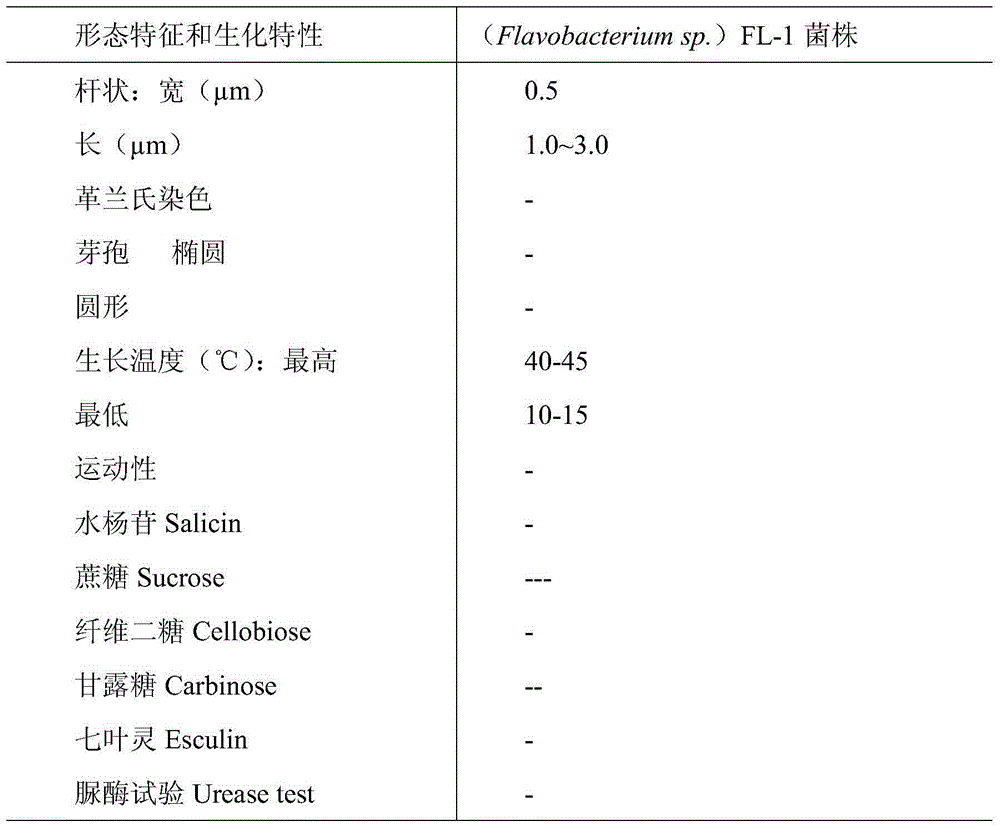Bifunctional strain capable of degrading cellulose and starch as well as separating and screening method and application of bifunctional strain
A technology for degrading cellulose, separating and screening, applied to a bifunctional bacterial strain for degrading cellulose and starch and its separation, screening and application fields, which can solve the problems of long cycle time and slow degradation of domestic waste, and achieve low cost and resource saving , high cellulose and amylase activity
- Summary
- Abstract
- Description
- Claims
- Application Information
AI Technical Summary
Problems solved by technology
Method used
Image
Examples
specific Embodiment approach 1
[0016] Specific embodiment 1: In this embodiment, a cellulose- and starch-degrading bifunctional bacterial strain is isolated and screened, which is Flavobacterium sp. FL-1, and is preserved in the China Common Microorganism Culture Collection Management Center, and the preservation address is Beijing No. 3, Courtyard No. 1, Beichen West Road, Chaoyang District, the city, the preservation date is January 4, 2015, and the preservation number is CGMCC No.10272.
[0017] The Flavobacterium sp. FL-1 of this embodiment is Gram-negative, straight rod-shaped, round-ended, does not form endospores, and is strictly aerobic.
[0018] Table 1 shows the physiological and biochemical indicators of Flavobacterium sp. FL-1 in this embodiment.
[0019] Table 1 Physiological and biochemical indicators of Flavobacterium sp. FL-1
[0020]
[0021]
specific Embodiment approach 2
[0022] Specific embodiment two: present embodiment a kind of method for separation and screening of degrading cellulose and starch bifunctional bacterial strain, it is to realize according to the following steps:
[0023] 1. Dilute the collected domestic waste soil samples with sterile water under aerobic conditions;
[0024] 2. Spread the diluted bacterial solution on the surface of the solid medium, and then incubate at a constant temperature of 5-15°C for 3-10 days;
[0025] 3. Pick a single colony in the liquid medium, and then culture it at a constant temperature of 10°C for 5 to 7 days;
[0026] 4. Repeat the operation of step 3 until the pure bacterial strain is isolated to obtain the dual-function bacterial strain for degrading cellulose and starch;
[0027] Wherein, the solid medium is cellulose solid medium and starch solid medium; the liquid medium is cellulose liquid medium and starch liquid medium.
[0028] This embodiment isolates and screens the cellulose-degr...
specific Embodiment approach 3
[0030] Specific embodiment three: the difference between this embodiment and specific embodiment two is: the cellulose liquid culture medium is made of 15.0g sodium carboxymethyl cellulose, 1.4g (NH 4 ) 2 SO 4 , 0.5g of MgSO 4 ·7H 2 O, 2.0 g of K 2 HPO 4 , 0.3g of CaCl 2 , 5mg of FeSO 4 ·7H 2 O, 1.6 mg of MnSO 4 , 1.7ng of ZnCl 2 , 1.7mg of CoCl 2 Made with 1000mL distilled water, adjust the pH to 7.0;
[0031] The starch liquid medium is made of 10g of soluble starch, 3g of beef extract, 10g of peptone, 5g of NaCl and 1000mL of distilled water, and adjusts the pH to 7.0;
[0032] The cellulose solid medium and the starch solid medium are made by adding 20 g of agar respectively on the basis of the above components. Other steps and parameters are the same as in the second embodiment.
PUM
 Login to View More
Login to View More Abstract
Description
Claims
Application Information
 Login to View More
Login to View More - R&D
- Intellectual Property
- Life Sciences
- Materials
- Tech Scout
- Unparalleled Data Quality
- Higher Quality Content
- 60% Fewer Hallucinations
Browse by: Latest US Patents, China's latest patents, Technical Efficacy Thesaurus, Application Domain, Technology Topic, Popular Technical Reports.
© 2025 PatSnap. All rights reserved.Legal|Privacy policy|Modern Slavery Act Transparency Statement|Sitemap|About US| Contact US: help@patsnap.com


